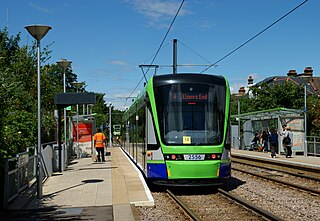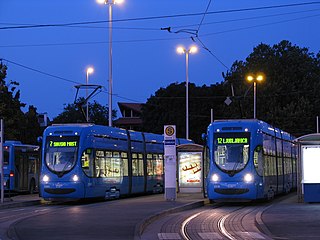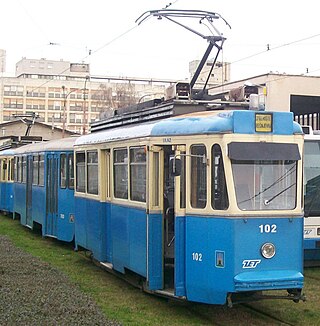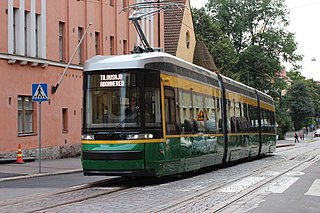
Trams in Helsinki form part of the public transport system organised by Helsinki Regional Transport Authority and operated by Metropolitan Area Transport Ltd in Finland's capital city of Helsinki. The trams are the main means of transport in the city centre, and 56.8 million trips were made on the system in 2019. In addition to the older tram network, there is a single light rail line that was opened in October 2023. Although technically compatible with the tram network, the light rail line is separate from the tram network.
Crotram is a Croatian consortium of two companies, which produces the first Croatian low-floor tram. It consists of Končar and TŽV Gredelj, both from Zagreb. Although theoretically both companies are of the same importance in the consortium, Gredelj produces only 13% of the worth of the tram, producing only bodies for the vehicle, and Končar made general projects for the tram, electrics, electronics, and final assembly. Initially, Đuro Đaković factory was also the part of the consortium, but they have eventually left it soon after the project started, and the development and production of hydraulics and bogie mechanics was transferred to German companies SAMES Hydro-Systemtechnik GmbH & Co. KG and Henschel Antriebstechnik GmbH.

Nr I is a class of articulated six-axle, chopper-driven tram operated by Helsinki City Transport on the Helsinki tram network. All trams of this type were built by the Finnish metal industry corporation Valmet between the years 1973 and 1975.

Škoda Transtech Oy is Finland's major domestic manufacturer of low-floor tram and railway rolling stock. It specializes in building tram and railway vehicles for extreme climatic conditions, such as those encountered in Finland.

The Stadler Variobahn is a German-designed model of articulated low-floor tram and light rail vehicle. Since its introduction in 1993, the Variobahn has been manufactured variously by ABB, Adtranz, Bombardier Transportation, and since 2001 by Stadler Rail. As of 2009, 254 trams have been ordered, with an additional 110 on option. A unit costs about €2.5 million.

Nr II is a class of articulated six-axle, chopper-driven tram operated by Helsinki City Transport (HKL) on the Helsinki tram network. All trams of this type were built by the Finnish metal industry corporation Valmet between the years 1983 and 1987.

KONČAR – Elektroindustrija d.d. is a Croatian electrical, transport and energy company based in the Trešnjevka neighborhood of Zagreb, Croatia.

HM V is a class of two-bogie four-axle tram operated by Helsinki City Transport on the Helsinki tram network. All trams of this type were built by the Finnish tram manufacturer Karia in 1959.

Transport in Zagreb, the capital of Croatia, relies on a combination of city-managed mass transit and individual transportation. Mass transit is composed of 19 inner-city tram lines and 120 bus routes, both managed entirely by Zagrebački električni tramvaj. Croatian Railways manages the parallel Zagreb Commuter Rail system. The city is served by the Franjo Tuđman Airport, which carries more than 3,300,000 passengers per year.

The Zagreb tram network, run by the Zagrebački električni tramvaj (ZET), consists of 15 day and 4 night lines in Zagreb, Croatia. Trams operate on 116.3 kilometres (72.3 mi) of metre gauge route. During the day every line runs on average every 5–10 minutes, but almost every station serves at least two routes. Nighttime lines have exact timetables averaging at about every 40 minutes. The first horsecar tram line was opened in 1891, and the first electric tram ran in 1910. Zagreb's tram system transported 204 million passengers in 2008.

The Osijek tram system is operated by the City Transport of Osijek and serves the city of Osijek, capital of the Slavonia region of Croatia.

TMK 2100 is a tramcar vehicle produced by Croatian companies Končar and TŽV Gredelj, between 1994 and 2003, using parts from TMK 201. The prototype was made in 1994, and serial production began in 1997. 16 trams have been ordered and delivered for the City of Zagreb.

TMK 201 is a type of four-axle tramcar produced by the Đuro Đaković factory that operates in the capital of Croatia, Zagreb. Previously, it was also used in Belgrade from 1970 to 1991. The first tram of this type was received by ZET on December 31, 1973, and the thirtieth-and-last of the type was delivered in June 1974. The new tram model was first put in service on January 22, 1974. Nine vehicles remain actively involved in the transport of passengers, and some were used for the production of TMK 2100 in the 1990s.

TMK 101 is a type of two-axle tramcar which was used in Zagreb (Croatia) from 1951 until December 2008, when the last vehicle of this type was withdrawn from regular service. They were single-ended and had all 3 doors on the right-hand side only, in conformity with standard Zagreb (ZET) operating practices. Maximum passenger capacity was 95, and they were fitted with two electric motors rated with a total continuous power output of 120 kW which gave a maximum speed of 55 km/h. The TMK 101 was the first modern type of tram produced in Croatia, featuring automatic door openers, driver's and conductor's seats, electrical, air-operated, and mechanical brakes, and a protective windshield at the front. Couplings were provided for trailer operation.

The Helsinki Regional Transport Authority is the inter-municipal authority that maintains the public transportation network of the nine municipalities of Greater Helsinki, Finland.

Artic, styled as ARTIC or ForCity Smart, is an articulated low-floor tram model designed and manufactured by Škoda Transtech Oy in Finland. Trams of the design are in operation in Finland, Germany and Czechia, with further large orders in these countries. The design was subsequently rebranded under the Škoda ForCity brand.

Until 2021, Helsinki was Finland's only remaining city with tram traffic. Two other cities—Turku (see Turku tram) and Vyborg —have had tram systems. Vyborg abandoned its trams in 1957 after it was ceded to the Soviet Union after the end of World War II. Turku withdrew its trams in 1972.

The Crown Bridges is the name given to three bridges under construction in the Finnish city of Helsinki, creating a new tram link and cycle path to the island of Laajasalo.

TMK 2300 is a low-floor tram produced by Končar - Electric Vehicles. It began production in 2009, based on further development of its predecessor, TMK 2200, using Končar's proprietary R&D and technology. The vehicle was exhibited at 2022 InnoTrans in Berlin.


















